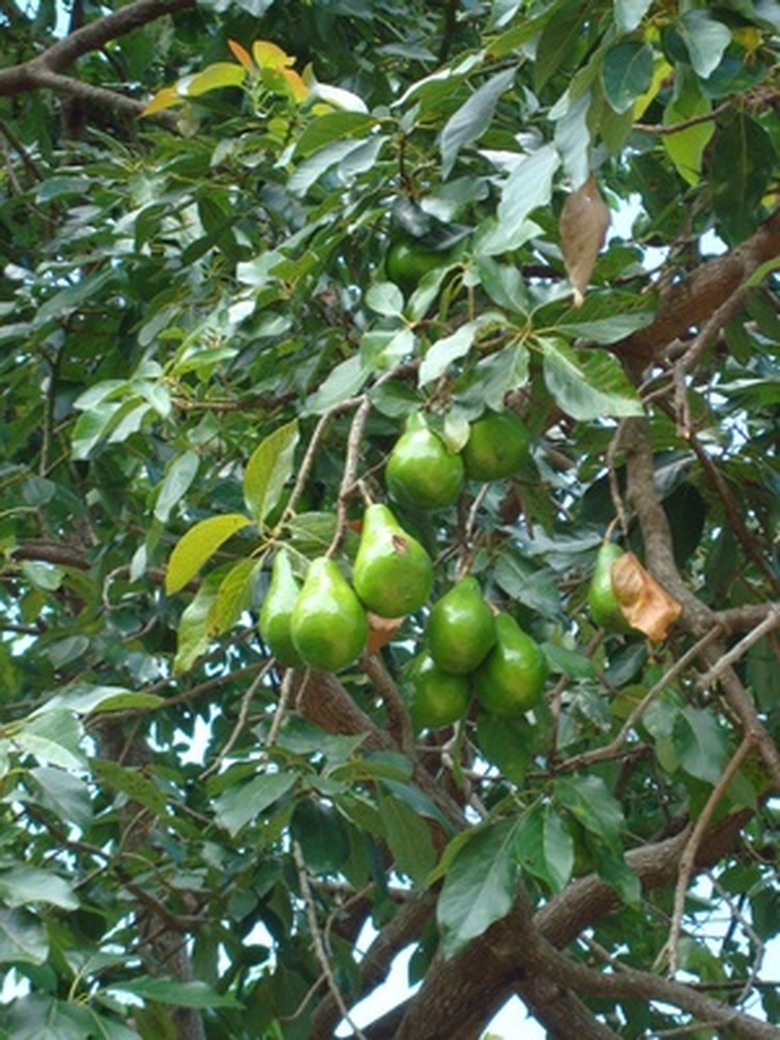Facts On Avocado Tree Roots
Avocados (Persea Americana) are native to Central and South America, as well as Mexico and the Caribbean, where they grow in dense highland rain forests. Avocado roots need warm soils, good drainage for constant oxygen exchange in the root zone, rich organic matter, and protection from high winds that might uproot the tree.
Size
The root system is relatively shallow, and does not extend far beyond the tree canopy, if it even reaches the edge of the canopy. The roots are primarily thin, fibrous feeder roots. They have no thick, anchoring taproot. These are likely adaptations to the shallow layer of rich soils in their native rain forest climates, as well as the absence of high winds in the dense forest growth that would necessitate better anchorage.
Soil
While they prefer rich soils, a top layer of decomposing mulch and organic material will also encourage feeder root growth. Again, this mimics their natural environment. According to "The Avocado: Botany, Production, and Uses," healthy avocado feeder roots thrive in any decomposing litter layer. Soil should drain readily, as avocado tree roots are susceptible to many different soil-borne diseases that thrive in soggy soils.
- Avocados (Persea Americana) are native to Central and South America, as well as Mexico and the Caribbean, where they grow in dense highland rain forests.
- Avocado roots need warm soils, good drainage for constant oxygen exchange in the root zone, rich organic matter, and protection from high winds that might uproot the tree.
Disease
Pytophthora cinnamomi, or cinnamon root rot, is one of the most common and dangerous root diseases of the avocado tree. Saturated soils, frequent rains or too-frequent watering simultaneously provide the perfect breeding ground for the disease while wearing down the root's natural defenses. The oxygen-starved roots start to die, and the disease breeds in the decaying root, quickly spreading to the rest of the healthy root system. Growing avocado with a thick layer of organic mulch has been shown to suppress phytophthora.
Root Hairs and Mycorrhiza
Avocado have very few to no root hairs on their feeder roots. Root hairs are the structures commonly associated with nutrient and water uptake in the root zone. Instead, avocado tree roots have a symbiotic relationship with a microscopic root fungus called mycorrhiza. This organism coats the roots, then forms a vast web out into the soil, where it absorbs nutrients for the roots in exchange for plant sugars.
- Pytophthora cinnamomi, or cinnamon root rot, is one of the most common and dangerous root diseases of the avocado tree.
- This organism coats the roots, then forms a vast web out into the soil, where it absorbs nutrients for the roots in exchange for plant sugars.
Hardiness
The roots and upper vegetation of Mexican avocado tree varieties can withstand cold much better than most other varieties: down to minus 8 degrees Celsius. Other rootstocks sustain damage even in above-freezing temperatures, but rarely die from such exposure. Protecting the roots with heavy mulch and watering right before a freeze may help reduce damage, but the upper parts of the tree may also need protection.
References
- "The Avocado: Botany, Production, and Uses"; Antony William Whiley, B. Schaffer, Bruce A. Schaffer, B. Nigel Wolstenholme; 2002
